Dental students, including Kayla McCullough (fourth year DMD/PhD student) and Tyra Avery (third-year PhD trainee student) from the University of Alabama at Birmingham's School of Dentistry attended this year's International Association for Dental Research (IADR) / American Association for Dental, Oral, and Craniofacial Research (AADOCR) General Session & Exhibition in New Orleans, Louisiana. The General Session featured oral and poster presentations, Hands-on Workshops, Lunch & Learning Sessions, Keynote Addresses, and Symposia presented by experts from all over the world.
McCullough and Avery share their experiences at the meeting and presentations:
Kayla McCullough
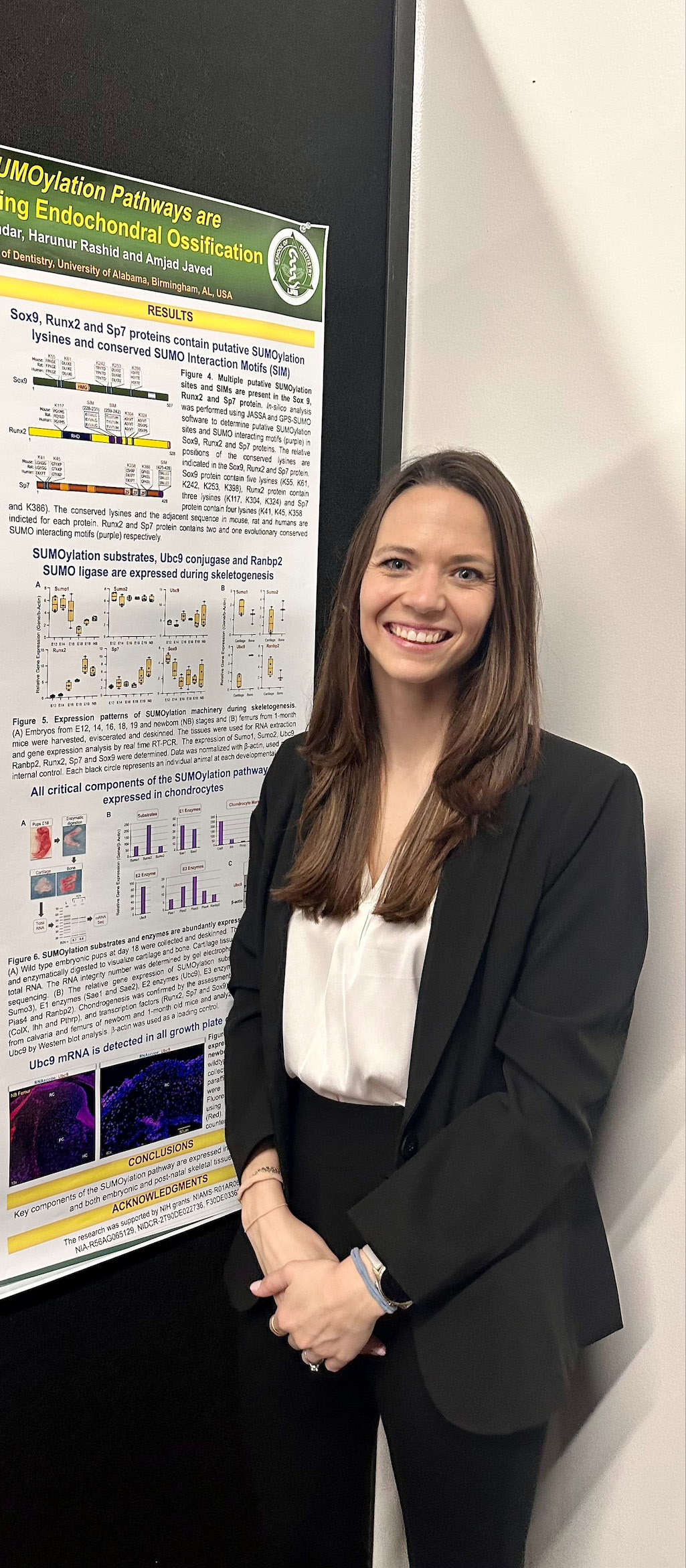 My name is Kayla McCullough, I am from Trussville, Alabama and I am a fourth year DMD/PhD student in Dr. Javed’s lab. My current project is focused on determining the role of the post-translational modification, SUMOylation during skeletal formation, specifically during endochondral ossification. I had two poster presentations and one oral presentation. The main thing I focus on when preparing my poster is ease of viewing and clarity of the data. I always want to ensure that the eye is drawn to the data by creating clean and colorful graphs that clearly display and describe the data. My oral presentation was the 411 Rapid Research competition. This presentation required me to present one PowerPoint slide to a non-specialist audience in 4 minutes. The preparation for this presentation required a very clean slide to avoid any distractions and a lot of practice to ensure that I hit all of my key points in 4 minutes. Attending the poster sessions was a great way to meet other researchers and discuss tips and tricks on how to successfully complete experiments. I really enjoyed meeting other DMD/PhD students. The most helpful session I attended was “Publishing your Manuscript: a JDR Perspective.” This session was led by Nick Jakubovics, the editor- in-chief of JDR. He provided great insight on how to best reach your target audience and how to present your research in a clear and concise manner for publication in scientific journals.
My name is Kayla McCullough, I am from Trussville, Alabama and I am a fourth year DMD/PhD student in Dr. Javed’s lab. My current project is focused on determining the role of the post-translational modification, SUMOylation during skeletal formation, specifically during endochondral ossification. I had two poster presentations and one oral presentation. The main thing I focus on when preparing my poster is ease of viewing and clarity of the data. I always want to ensure that the eye is drawn to the data by creating clean and colorful graphs that clearly display and describe the data. My oral presentation was the 411 Rapid Research competition. This presentation required me to present one PowerPoint slide to a non-specialist audience in 4 minutes. The preparation for this presentation required a very clean slide to avoid any distractions and a lot of practice to ensure that I hit all of my key points in 4 minutes. Attending the poster sessions was a great way to meet other researchers and discuss tips and tricks on how to successfully complete experiments. I really enjoyed meeting other DMD/PhD students. The most helpful session I attended was “Publishing your Manuscript: a JDR Perspective.” This session was led by Nick Jakubovics, the editor- in-chief of JDR. He provided great insight on how to best reach your target audience and how to present your research in a clear and concise manner for publication in scientific journals.
Background: During organogenesis, post-translational modifications regulate cell migration, proliferation, differentiation, and apoptosis. SUMOylation is a ubiquitin-like post-translational modification that alters the target protein’s stability, activity, and cellular distribution. Protein SUMOylation occurs during normal development but the functional role of SUMOylation during skeletogenesis remains largely unknown. The objective of this study is to determine the expression of SUMOylation substrates and enzymes during skeletal development. Skeletal tissue from eviscerated/deskinned wild-type embryos were collected for RNA and protein isolation at day-12, 14, 16, 18, 19, newborn (NB) and 1-month stages and analyzed by real time- PCR and western blotting. Spatio-temporal expression of selected SUMOylation pathway genes was evaluated by histologic sectioning and labeling of NB femurs using RNAScope and immunofluorescence.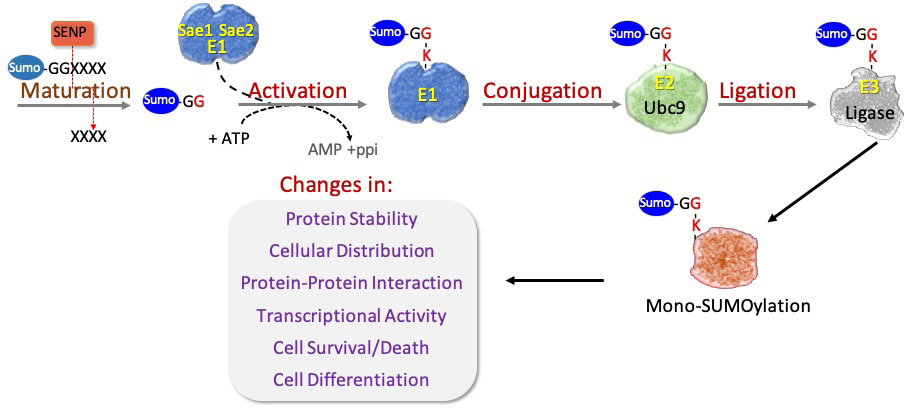
Results: Skeletogenesis in mice, initiated at embryonic day 11.5, progressively increases through embryonic and postnatal life. Expression of both Runx2 and Sp7 confirmed the progression of bone development. We find the level of Runx2 and Sp7 increased by 13-fold from E12 to NB stage. The SUMO-substrates, SUMO1 and SUMO2 were expressed at all timepoints. While SUMO2 is constitutively expressed throughout skeletal development, SUMO1 expression decreased progressively from E12 to NB stage. Expression of required substrates and enzymes for SUMOylation, specifically in chondrocytes, was established by mRNA-sequencing of purified chondrocytes from E18 pups. We found a broad expression of all essential components of SUMOylation-pathway indicating the involvement of SUMOylation during chondrogenesis. Finally, the spatio-temporal expression of selected SUMO substrates and enzymes was confirmed by RNAScope and immunofluorescence in femurs of NB mice. In conclusion, it was found that essential components of the SUMOylation pathway are expressed in skeletal tissue. Now that this expression has been confirmed, I will use mouse models to delete Ubc9 in specific chondrocytes. This will halt SUMOylation in chondrocytes, allowing us to get a better understanding of the role of SUMOylation during endochondral ossification. This critical knowledge may result in novel therapeutics for many skeletal disorders such as arthritis and osteoporosis.
Tyra Avery
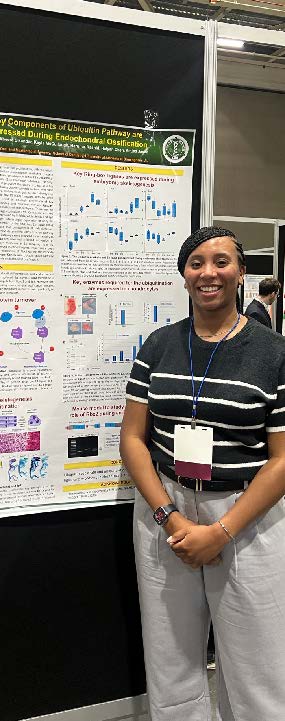 I am a third-year PhD trainee student at the UAB School of Dentistry. I am originally from Nashville, Tennessee where I graduated with my bachelor’s degree from Belmont University and a master’s degree from the illustrious Fisk University. I found my passion for human health research and education. I’m currently in Dr. Javed’s lab determining the role of RING-box protein 2 (Rbx2), a key enzyme for ubiquitination, during embryonic and postnatal bone formation.
I am a third-year PhD trainee student at the UAB School of Dentistry. I am originally from Nashville, Tennessee where I graduated with my bachelor’s degree from Belmont University and a master’s degree from the illustrious Fisk University. I found my passion for human health research and education. I’m currently in Dr. Javed’s lab determining the role of RING-box protein 2 (Rbx2), a key enzyme for ubiquitination, during embryonic and postnatal bone formation.
While pursuing my undergraduate degree my research focused on green titrimetric analysis. Our goal was to create interactive and inexpensive labs for high school students in the Nashville area while maintaining academic standards. We hosted teachers and students from nearby schools to teach various chemistry techniques. This experience motivated me to continue research while focusing on education. After graduating I spent a year expanding my research at Vanderbilt University focusing on Alzheimer’s disease in African Americans. Researching Alzheimer’s disease allowed me to understand how research directly impacts human health. My passion for research grew further, and I made professional connections with my mentors and students.
A major takeaway is that I met many great individuals whose research focuses on the development and disorders of craniofacial and bone. We discussed our challenges, shared new research ideas and techniques, how to improve the experimental design of our research and future career goals. In addition, I attended a session about “Oral Health and Systemic Conditions.” I gained a new perspective on how oral health is affected by mental disorders, Alzheimer’s disease, and morbidity beyond effective brushing and diet.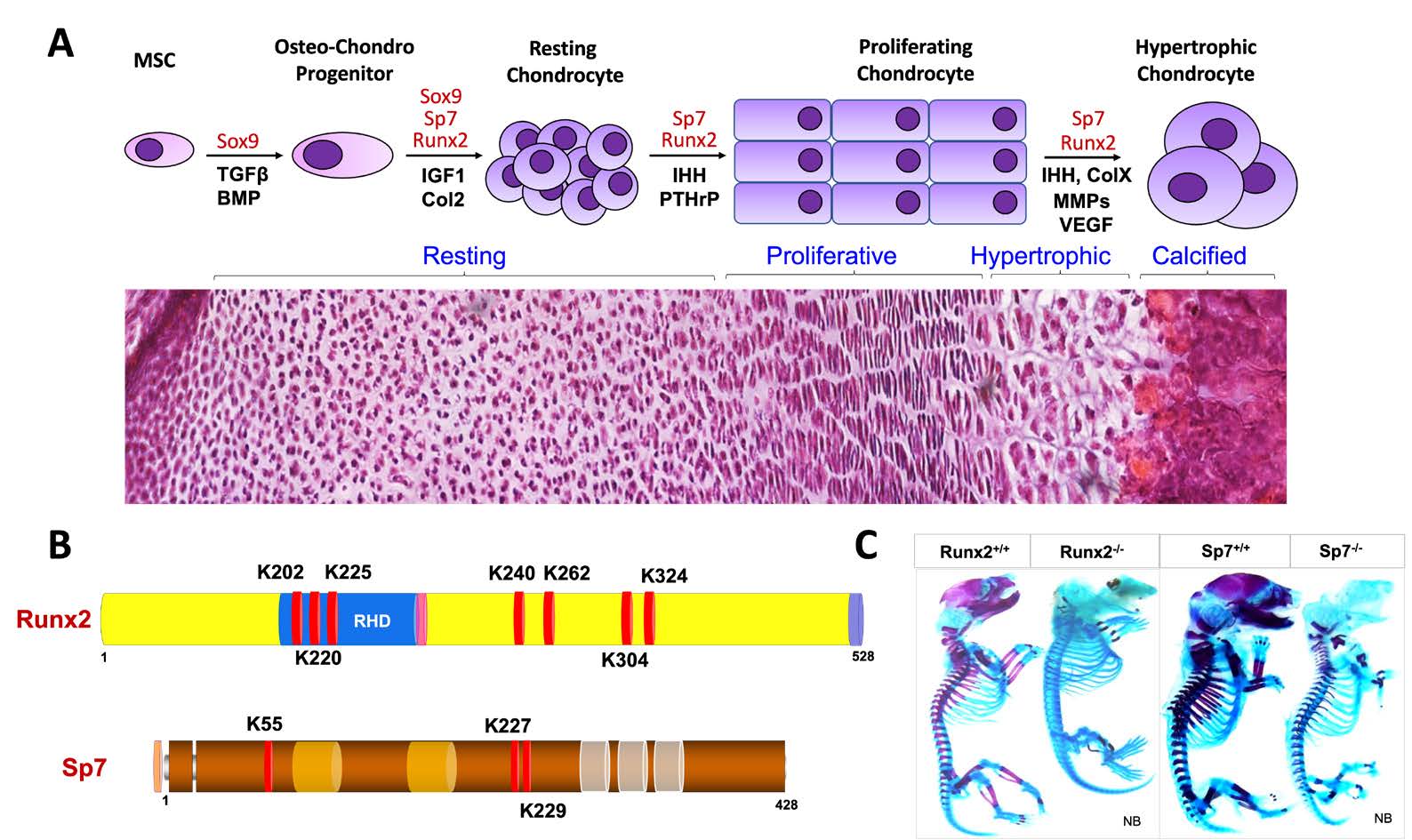
Ubiquitination is a post-translational modification that regulates essential cell processes of proliferation, differentiation, and autophagy through protein degradation. The ubiquitination-proteasomal mediated protein degradation requires three sequential enzymes. Initially, the ubiquitin substrate is activated by the E1-activating enzyme. Then activated-ubiquitin is transferred to the E2 conjugating enzyme, and finally, the E3-ligase transfers ubiquitin to the lysine residue in a target protein. The poly-ubiquitinated target protein is degraded by the proteasomal pathway. Over 500 E3-ligases are present in humans and are categorized into three main classes. The largest class is the RING-box proteins which contain a cullin scaffolding protein, an adaptor protein, a substrate recognition protein, and a catalytic subunit RING-box proteins. Ubiquitination depends on the Really Interesting New Gene-box proteins 1 and 2 (Rbx1) and (Rbx2), the only catalytic subunits in the complex. The global deletion of either the Rbx1 or Rbx2 gene leads to early embryonic lethality, prior to the development of skeletal tissue. During embryonic development, Rbx1 and Rbx2 have non-redundant functions, as neither can compensate for the loss of other. Rbx1 and Rbx2 are critical for survival and many biological processes; however, the specific role of Rbx2 E3 ligase during skeletogenesis remains unknown.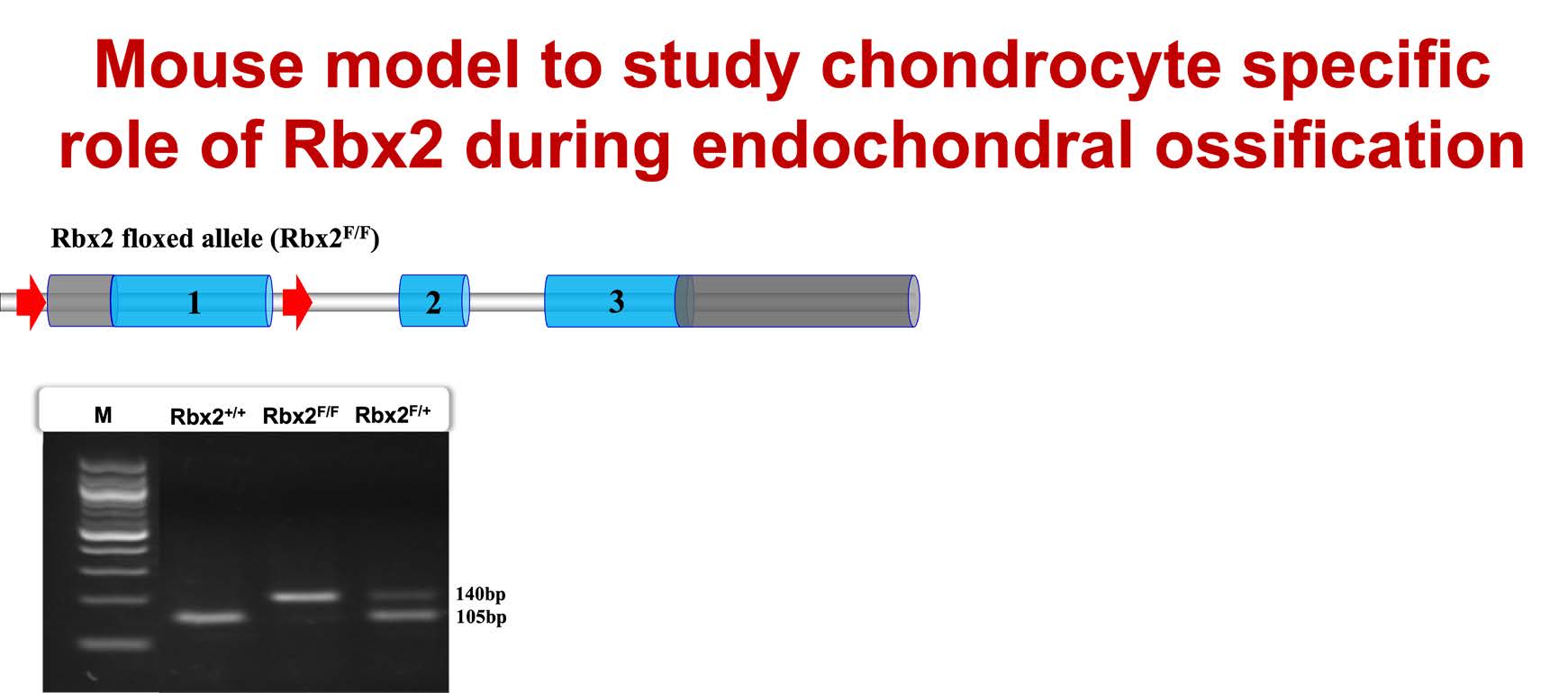
Story originally published in Vol II, Spring 2024 Bridging the Gap, a newsletter of the UAB Local Student Research Group.